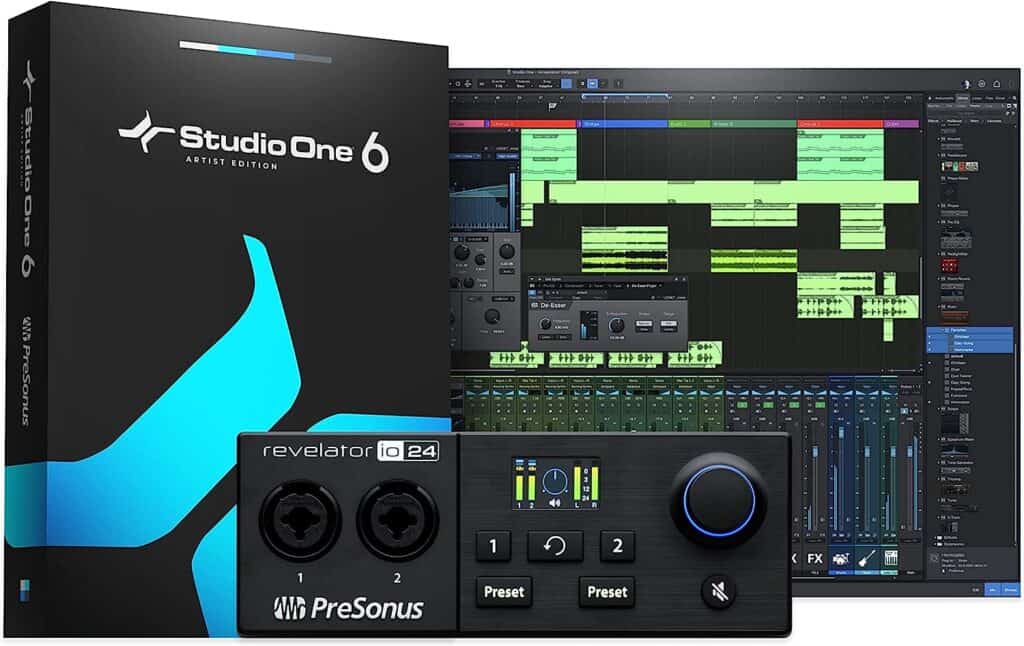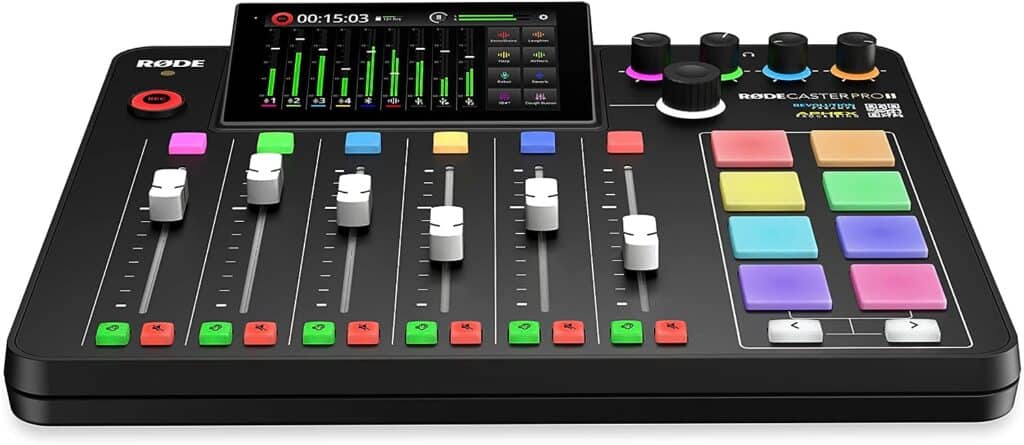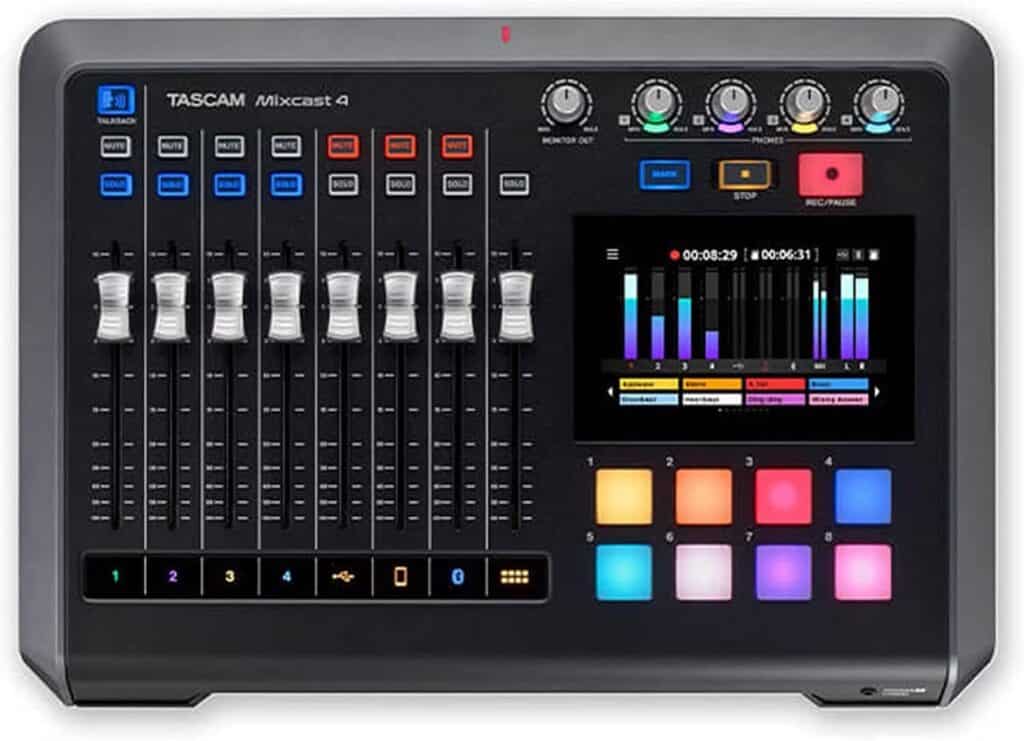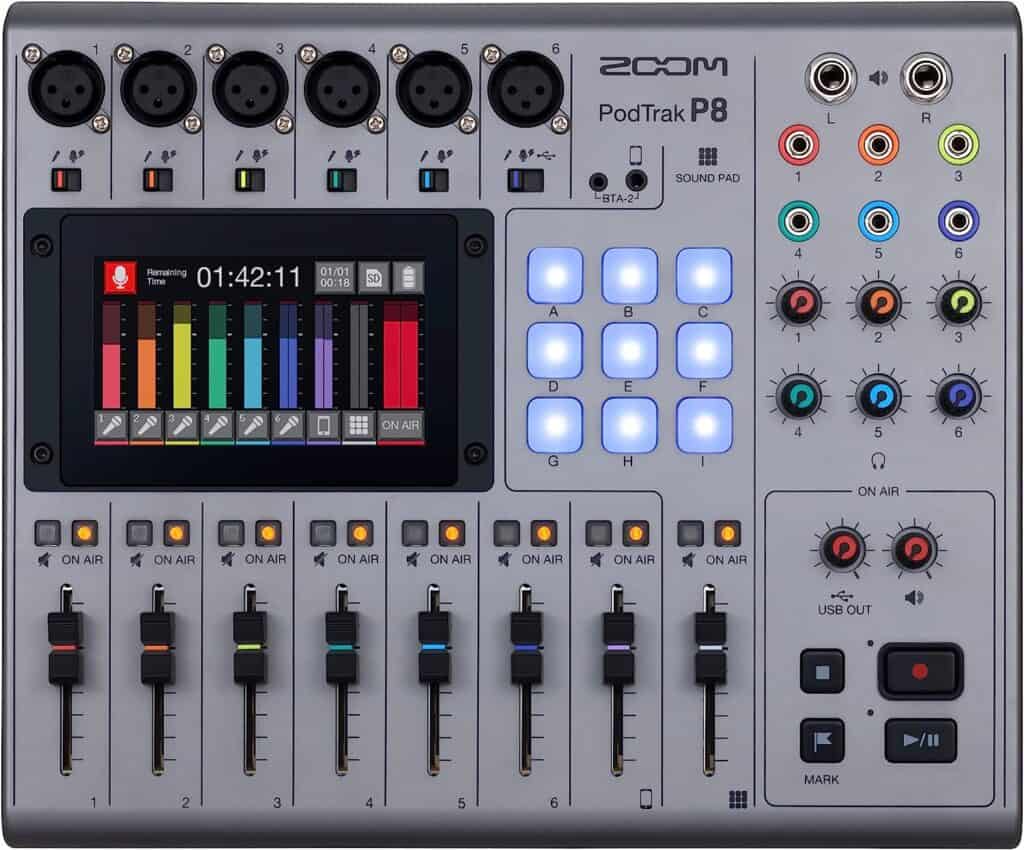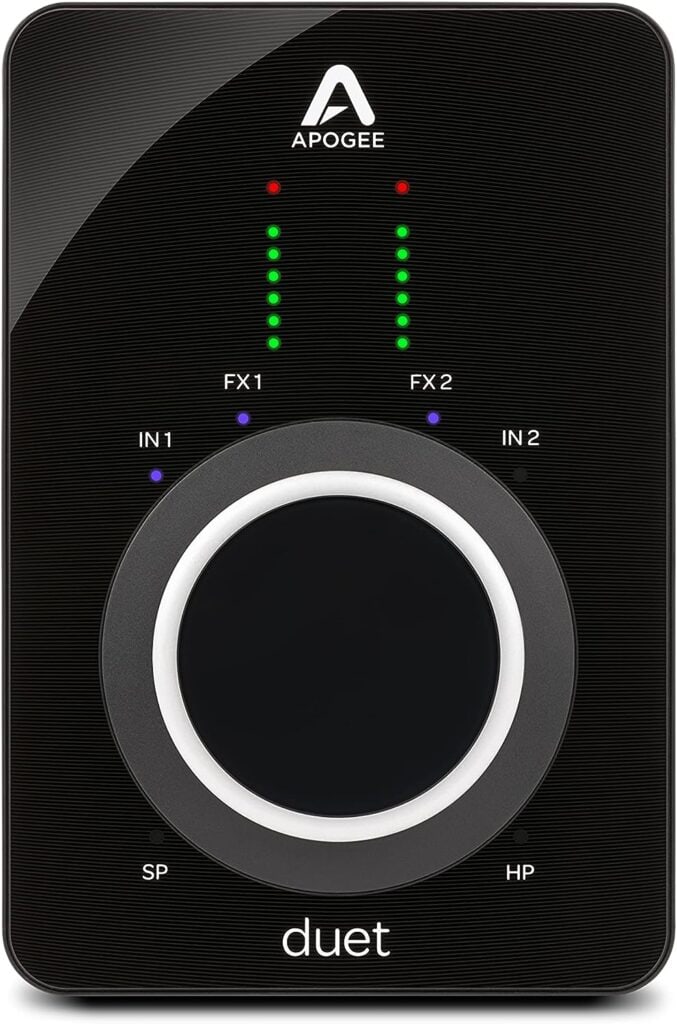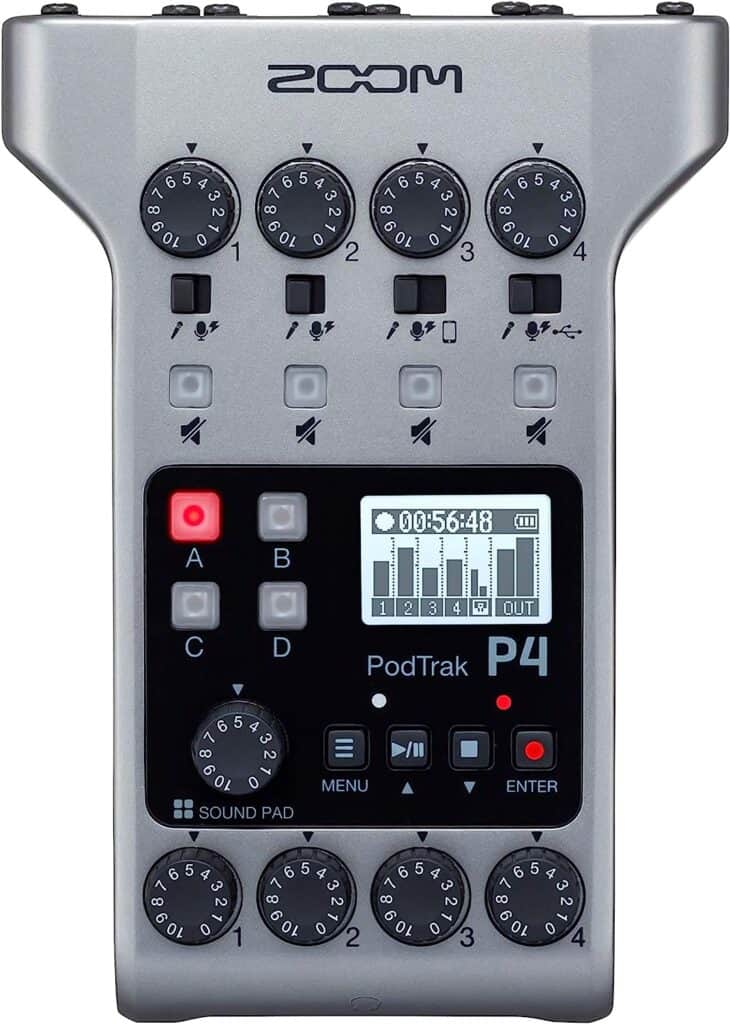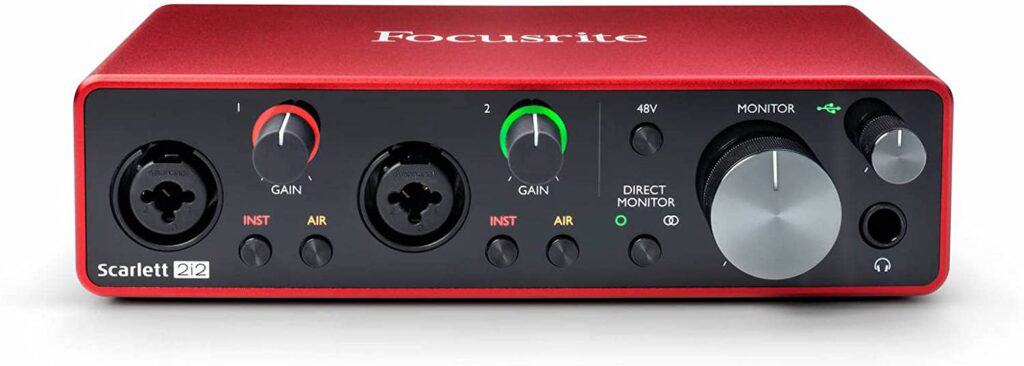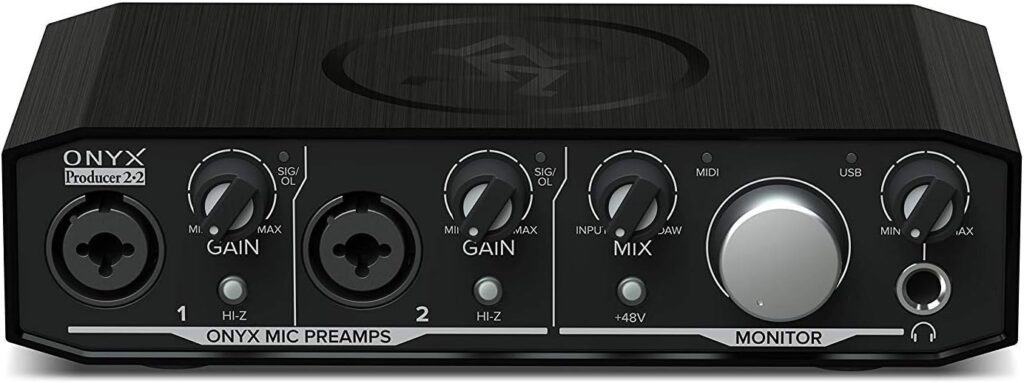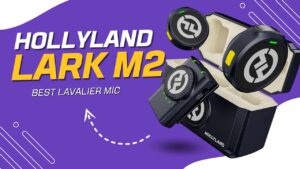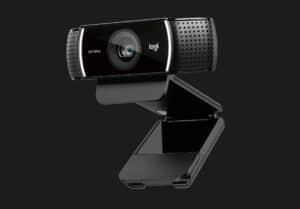An audio interface is a vital tool for podcasters and content creators, serving as a bridge between microphones and computers. It enables high-quality audio recording, playback, and processing. In this article, we’ll explore some of the best audio interfaces for podcasting, considering factors like audio quality, connectivity, and versatility.
Castos is a participant in the Amazon Services LLC Associates Program. We may earn commissions from your purchases on Amazon.com, though at no cost to you.
What is an Audio Interface?
An audio interface is like the bridge that connects your microphone or other audio sources to your computer. Imagine it as the translator between the real world sound and the digital world your computer understands.
When you’re podcasting, you want your voice or your guests’ voices to sound crisp and clear. That’s where the audio interface comes in. It takes the analog signal from your microphone and turns it into a digital format that your computer can work with. This is important because it ensures your podcast doesn’t sound like it’s recorded in a tin can.
Think of it like having a professional sound engineer right in your setup. Some interfaces also come with handy features like volume controls, headphone outputs, and even effects like EQ or compression to make your audio sound even better.
So, in simple terms, an audio interface is a must-have tool for podcasters that helps you capture great sound, make it digital, and get it ready for your listeners’ ears.
The 8 Best Audio Interfaces for Podcasting
Now that you understand how an audio interface works and why you need one, let’s go through our list of the best audio interfaces for podcasting.
1. PreSonus Revelator io24
The PreSonus Revelator io24 offers a balanced blend of advanced features and user-friendly design. Its high audio quality and versatile inputs cater to lots of different microphone setups, fostering professional-grade sound.
The StudioLive Voice Effects presets, tailored for podcast vocals, creates excellent clarity. The Bluetooth 5.0 connectivity enables hassle-free integration of remote guests or phone interviews.
Dual headphone outputs with individual volume control accommodate multiple hosts or guests for seamless real-time monitoring. The bundled Studio One Artist software supports recording, editing, and production processes. Notably, the loopback functionality makes including external audio simple, which streamlines content creation.
While it might be pricier, the Revelator io24’s comprehensive features and intuitive interface make it an appealing option for podcasters aiming to elevate their podcasting experience and overall production quality.
2. Rode RODECaster Pro II
The Rode RODECaster Pro II is a solid choice for podcasters, mainly because it’s like a podcasting studio all packed into one box.
First off, its sound quality is top-notch, ensuring that your podcast episodes sound professional and clear. It comes with multiple microphone inputs, making it great for group discussions or interviews. One cool thing is the built-in sound effects and jingles – they add a fun touch without needing extra gear.
The touchscreen interface is super user-friendly, letting you easily control your recordings and make adjustments on the fly. Plus, the RODECaster Pro II allows you to take calls from your phone or computer, so you can have remote guests without any hassle.
However, it’s worth mentioning that the price is on the higher side. If you’re just starting out or on a tight budget, this might be a drawback. But if you’re serious about podcasting and want a setup that’s versatile and doesn’t require a bunch of separate components, the RODECaster Pro II could be a game-changer for your podcasting journey.
3. Tascam Mixcast 4
The Tascam Mixcast 4 is all about simplicity without skimping on quality. With four XLR inputs, you can easily host a small group or interviews. It keeps things hassle-free – no need for a bunch of extra gear.
The real charm lies in the sound quality from the preamps. The Mixcast 4 comes with Tascam’s audio expertise, so your podcast episodes sound clear and professional. Plus, it’s got built-in EQ and compression, saving you from post-production headaches.
The USB connectivity makes it a breeze to hook up to your computer, and you can even route sound from your phone via Bluetooth. This means remote guests or adding external audio is a snap, but it’s a bit overkill if you podcast alone.
What we don’t like about it: No built-in effects, though they are accessible with the TASCAM editing software.
4. Zoom PodTrak P8
The Zoom PodTrak P8 is one of the best audio interfaces for podcasting. Its standout feature is the ability to handle eight channels of audio, letting you connect up to six XLR microphones and two stereo inputs. This is a game-changer for group discussions or interviews, making sure all voices are captured.
What’s cool is that it comes with built-in effects processing, like compression and equalization, ensuring your audio sounds polished without needing extra gear or software tweaks. And those programmable sound pads? They’re a neat way to spice up your podcast with sound effects or jingles.
The full-color touchscreen is a breeze to use, making controls and navigation straightforward. Whether you’re in a studio or recording on the move, the connectivity options – USB, mini jack for phones, and even Bluetooth – cover all bases.
While this interface has a lot of features, there’s a bit of a learning curve. But if you’re serious about podcasting and want an all-in-one solution that delivers high-quality audio and lets you get creative without being a tech wizard, the Zoom PodTrak P8 could be your podcasting companion.
5. Apogee Duet 3
The Apogee Duet 3 offers fantastic audio quality. It’s known for its top-notch sound, making your podcast voices sound clear and pro-level.
The two combo inputs let you plug in microphones or instruments, perfect for interviews or adding some musical flair to your podcast. Plus, it’s designed with ease of use in mind. You don’t need to be a tech guru to set it up.
The Duet 3 has a sleek touchscreen that makes adjusting levels and settings feel intuitive. No more hunting around in confusing menus. And if you’re recording on the go, it’s super portable.
While the Duet 3 is one of the best audio interfaces, it doesn’t have many inputs, so it’s not suitable for group podcasts. Larger setups would need a larger audio interface.
6. Zoom PodTrak P4 Portable
The Zoom PodTrak P4 Portable is a versatile and compact podcasting solution that packs a punch. Designed with podcasters in mind, it offers four XLR microphone inputs, making it perfect for interviews, group discussions, or solo recordings with multiple mics. Its preamps ensure clear and professional-grade audio quality.
But what really sets the PodTrak P4 apart is its intuitive functionality. It lets you easily control and monitor your recordings. The onboard effects processing elevates your audio without the need for post-production tweaks.
Additionally, the P4 boasts programmable sound pads for adding jingles or sound effects, adding an extra layer of creativity to your podcast. The USB connectivity allows easy integration with your computer, while the battery-powered option makes it convenient for recording on the go.
7. Focusrite Scarlett 2i2
The Focusrite Scarlett 2i2 is an ideal audio interface for podcasters seeking professional-grade sound quality in a compact package. With its two high-quality microphone preamps and sample rates up to 24-bit/192kHz, it captures audio with remarkable clarity and detail.
The 2i2’s versatile inputs accommodate both XLR and 1/4″ connections, allowing you to connect microphones, instruments, or line-level sources.
Designed for ease of use, the 2i2 features intuitive gain controls, direct monitoring options, and easily accessible headphone and speaker outputs. Its “Air” mode adds a subtle brightness to recordings, enhancing vocal presence. USB connectivity ensures compatibility with various recording software and operating systems.
The rugged and sleek metal housing makes it suitable for portable podcasting setups, while Focusrite’s acclaimed low-latency drivers guarantee seamless real-time monitoring.
Whether you’re a beginner or a seasoned podcaster, the Scarlett 2i2 offers a user-friendly, professional-grade solution for capturing your voice, interviews, and sound effects with exceptional audio fidelity.
8. Mackie Onyx Producer 2×2
The Mackie Onyx Producer 2×2 stands out as one of the best audio interfaces for podcasting due to its compelling benefits for content creators.
Its pristine audio quality ensures that your podcast recordings are clear and professional, enhancing your content’s credibility. The Onyx preamps deliver rich, detailed sound, making your voice, interviews, and discussions come to life.
With a focus on ease, the Mackie Onyx Producer 2×2 streamlines your podcasting process. Its user-friendly interface and controls allow you to quickly adjust levels and settings, saving you valuable time during recording sessions. The integrated recording software ensures a hassle-free setup, letting you concentrate on your content without technical distractions.
The inclusion of direct monitoring empowers podcasters to hear themselves and their guests in real-time, avoiding delays and maintaining natural conversations. Its compact and robust design makes it suitable for both studio and remote setups, ensuring consistency in audio quality wherever you record.
How to Choose an Audio Interface for Podcasting
Choosing an audio interface for your podcast involves considering several key factors to ensure you get the right tool for your needs. Here what you should consider:
Budget
Determine how much you’re willing to spend. Audio interfaces come in various price ranges, so setting a budget helps narrow down your options. Make sure your new interface fits into your overall podcast budget.
Number of Inputs
Consider how many microphones or audio sources you’ll use regularly. If you plan on having multiple hosts or guests, you’ll need an interface with enough XLR or combo inputs.
Sound Quality
Look for interfaces with good preamps and A/D converters to ensure clear and professional audio quality. Reviews and user feedback can give you insights into this aspect. Ideally, it helps to speak to someone who knows a lot about audio engineering.
Features
Consider what features are important to your podcast. Do you need built-in effects, sound pads, or headphone outputs for multiple hosts? Think about your specific requirements.
Portability
If you’ll be recording on-the-go, opt for a portable interface with USB bus power or battery operation. If your remote recording requires the use of a phone, make sure to consider the right equipment you need to connect them together.
Connectivity
Check if the interface offers the right connections for your setup. USB and XLR are common, but you might also need features like Bluetooth or MIDI.
Software Compatibility
Ensure the interface works well with your recording software and operating system. Many of the best audio interfaces come with editing software that’s designed for the device.
Ease of Use
A user-friendly interface with intuitive controls can save you time and frustration during recordings. This is critically important if you don’t have a lot of experience with audio editing. Better recordings make for less editing and faster content creation.
Reviews and Recommendations
Read reviews from podcasters who have used the interface you’re considering. Their experiences can provide valuable insights.
Future Growth
Consider your podcast’s potential growth. Will you need more inputs or advanced features down the line? Do you expect to use live effects during your recording session? Will you have multiple guests at the same time? Future-proofing your setup can save you from upgrading too soon.
Brand Reputation
Established brands often have a track record of producing reliable products. Look for brands known for their audio quality and durability. If a brand has a history of making bad products, the audio interface you’re considering might be bad too.
Support and Warranty
Ensure the interface comes with good customer support and a reasonable warranty period. Check reviews to learn about customer experiences regarding support.
Remember, the best audio interface for your podcast depends on your unique requirements and goals. Take your time, do thorough research, and choose one that aligns with your podcasting style and ambitions.
Your Favorite Audio Interfaces
What devices do you think are the best audio interfaces for podcasting? What do you use for your personal podcast? Let us know in the comments.
